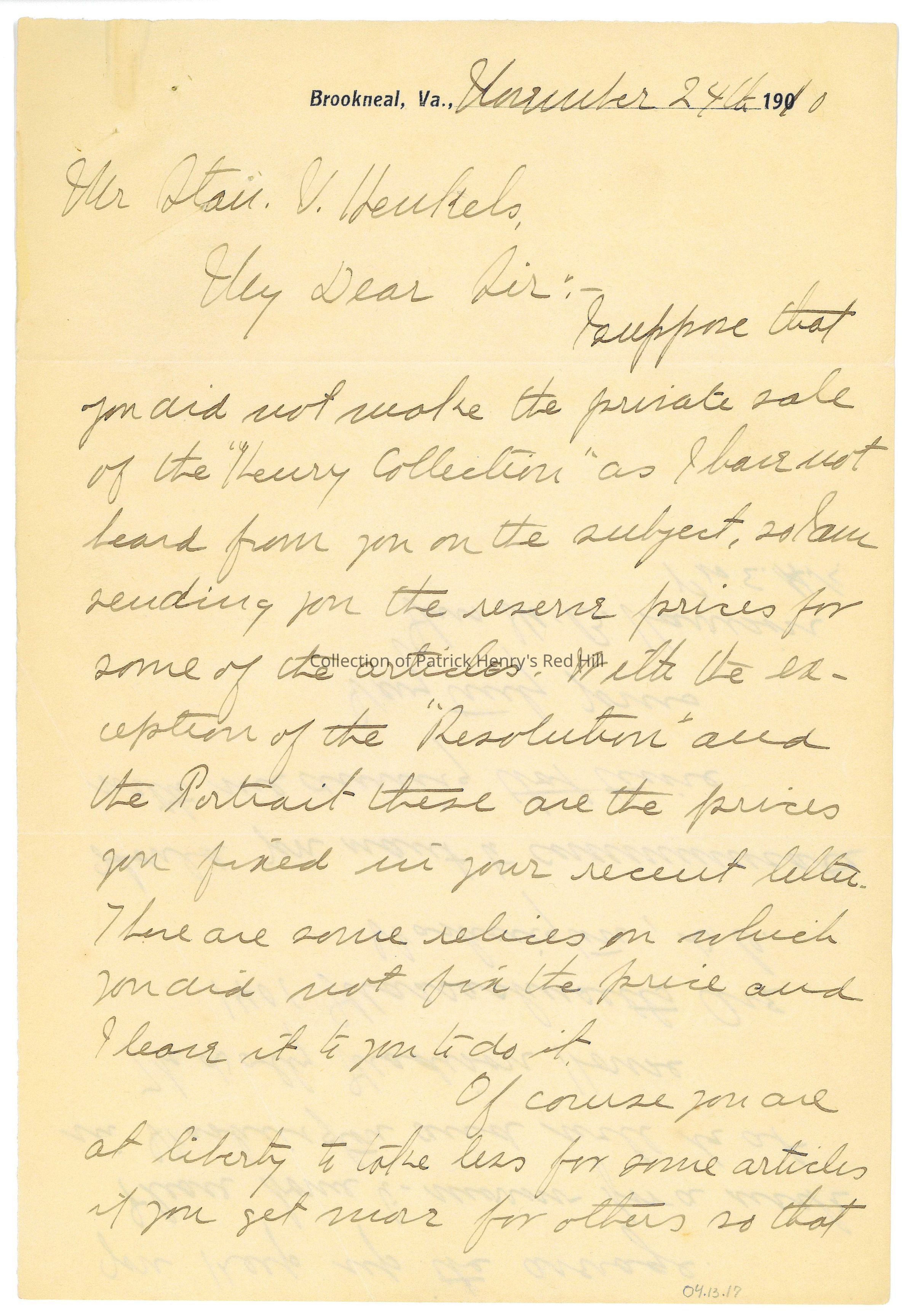Notes
This letter belongs to a collection of correspondence primarily from Lucy Gray Henry Harrison (1857–1944) to Stanislaus “Stan” Vincent Henkels (1854–1926) concerning a proposed sale of Patrick Henry family heirlooms in 1910. Mrs. Harrison was Patrick Henry's great-granddaughter and the last Henry descendant to own and live at Red Hill. She grew up in Richmond, Virginia, and moved to Duluth, Minnesota, after marrying real estate millionaire Matthew Bland Harrison (1853–1892) in 1886. In 1905, she inherited Red Hill and moved onto the property, where she lived along with her sister, Elizabeth Watkins Henry Lyons (1855–1920), and her assistant, Elizabeth H. Kerper (1890–1964).
Mrs. Harrison inherited many of the family heirlooms that had belonged to Patrick Henry and many of his papers. In 1910, on the advice of Philadelphia neurologist and writer Dr. Weir Mitchell (1829–1914), she contacted Stan V. Henkels about a possible private sale or public auction of some of these pieces. Mr. Henkels was an antique dealer in Philadelphia well-known for his auctions and private sales to collectors. The correspondence from Mrs. Harrison to Mr. Henkels details their business negotiations from May 1910 leading up to the sale of the items in Philadelphia on December 20, 1910. It also includes letters concerning a settling of accounts between them up through February 1911.
The Henry heirlooms Mrs. Harrison sent to auction included a collection of Henry’s letters and other documents. One of these was Henry’s handwritten draft of the Stamp Act Resolves, which Charles Hamilton (1847–1930) bought for $1,400 and is now in the special collections of Colonial Williamsburg’s John D. Rockefeller Jr. Library.
Thomas Sully’s (1783–1872) portrait of Patrick Henry is an oil painting on canvas commissioned in 1815 by Henry’s first biographer, William Wirt (1772–1834). An engraving of the portrait was featured on the frontispiece of Wirt’s 1817 biography, “Sketches of the Life & Character of Patrick Henry.” Sully based the portrait on one of the few images of Henry painted from life: a 1795 miniature created by Sully’s half-brother, Lawrence Sully (1769–1804). Thomas Sully’s portrait of Henry was given by Wirt to Henry’s youngest son, John (1796–1868), who passed the portrait on to his son William Wirt Henry (1831–1900), who loaned it to the Virginia State Library in Richmond from 1873 to 1884 before he passed it on to his daughter, Lucy Harrison. In 1902, Mrs. Harrison loaned the portrait again to the Virginia State Library but reclaimed it in 1910 to sell it at Mr. Henkels’ auction, where it was purchased by Charles Hamilton for $4,000. The Colonial Williamsburg Foundation later purchased the portrait from the Hamilton family and currently has it in its collection.
The two pieces of furniture Mrs. Harrison sent to auction were Henry’s desk and corner chair. A photographed image of the desk appears in the 1907 biography, “The True Patrick Henry” by George Morgan. Mrs. Harrison shipped the desk to Philadelphia in June 1910, and it was sold on order at the December auction for $500. The desk is pictured in Mr. Henkels’ December 1910 auction catalog (76.5.2), along with the corner chair and the caster set. The black walnut corner chair passed directly through the Henry family line from Patrick to Lucy Harrison, and it is said to be the chair in which Henry was sitting when he died on June 6, 1799 of complications from intussusception. An image of the chair appears in “The True Patrick Henry” and the auction catalog (76.5.2). It was sold on order for $225, then later given to the Colonial Williamsburg Foundation by Elizabeth Gribbel Corkran (1897–1976), a descendant of the buyer.
The silver caster set (96.1.1-6) owned by Patrick Henry is in the Red Hill collection. Henry may have purchased the casters at the 1776 sale of the belongings of John Murray, 4th Earl of Dunmore (1730–1809), as Mrs. Harrison mentions in her December 10 letter to Mr. Henkels (04.13.19). The set was sold to Charles Hamilton for $200 at the December 1910 auction. Mrs. Harrison also sent a silver plate frame (or stand) to Mr. Henkels, which was sold at the auction to a Mr. Smith for $16.
Patrick Henry’s sword cane — a walking stick with a metal head—was presented to the Virginia State Library in June 1902 by Elizabeth Henry Lyons. The cane was returned to Red Hill sometime before Mrs. Harrison contacted Mr. Henkels about the auction, and she shipped it to him on June 16, 1910. At auction, it was sold for $25 to a Mr. Bixby.
The steel shoe buckles were advertised in Mr. Henkles’ auction catalog as the ones Henry likely wore when he delivered his speech against the Stamp Act to the Virginia House of Burgesses in 1765. Mrs. Harrison sent the buckles to Mr. Henkels in June 1910, and they were sold at auction to Charles Hamilton for $16.
The Dolley Madison House in Washington, D.C., was built in 1818–1819 as the home of Massachusetts congressman Richard Cutts (1771–1845) and Anna Payne Cutts (1779–1832), the sister of Dolley Madison (1768–1849). Mr. Cutts sold the house to former President James Madison (1751–1836). Mrs. Madison moved into the house after her husband’s death and lived there for the remainder of her life. At the time of Mrs. Harrison’s visit, the house was owned by the Cosmos Club, a private social club for D.C. intellectuals founded in 1878.
The Patrick Henry Memorial Foundation purchased this letter from an online seller in May 2004 as part of the collection of correspondence.
